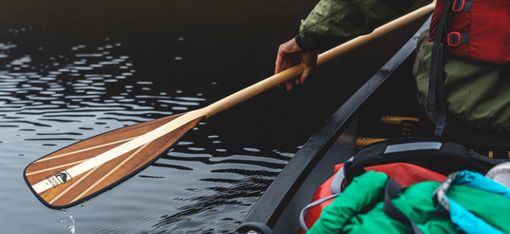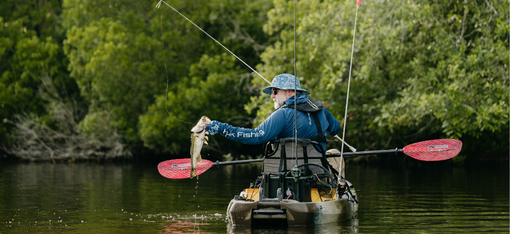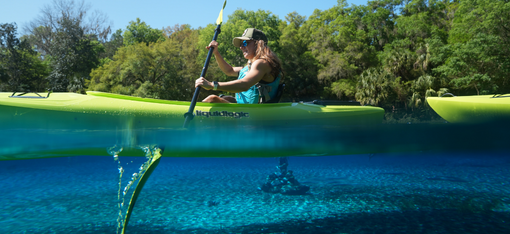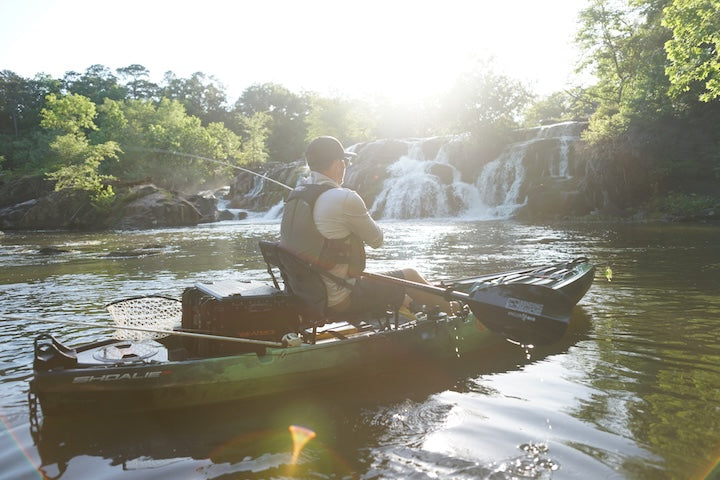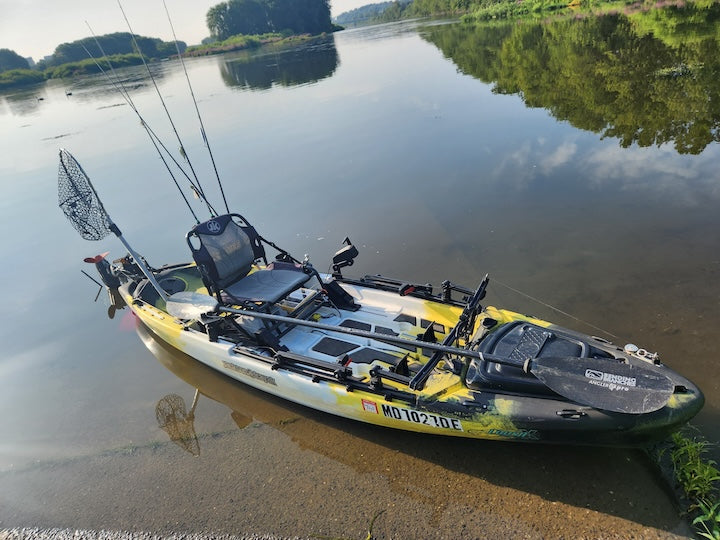Adaptive Kayaking and Canoeing Get More People on the Water
7-minute read + 9-minute video
Here at Bending Branches, one of our main goals is to get more people out on the water in canoes and kayaks. That’s why we believe in adaptive kayak and canoe programs and equipment.

Special gear adaptions for paddling help get people with disabilities on the water easier (photo courtesy of Mike Schmitz)
When people with physical, emotional and mental challenges and disabilities learn to paddle in a canoe or kayak, it opens up their world in a new way. Some experience the freedom they don’t have on dry land. Others find it healing—being on the water, being in nature.
Here are a few people and organizations we’re connected with or know about who are doing great work in this area of adaptive paddling:
Branches’ Regional Ambassador Mike Schmitz: Personal Experience
Mike Schmitz has been a wheelchair user since a car crash left him partially paralyzed at 18 years old. When he kayak fished for the first time a few years ago, he found a new freedom in being able to propel himself on the water in a way he can’t on land.
On the water “I don’t have any more barriers. I have the freedom to move around. I have the freedom to go where I want to, and the freedom to do what I want to. Once I’m on the water and I’m sitting in that kayak next to somebody else—waiting for a tournament to start or just a friendly fishing day—we’re on even keels…I don’t have to worry about whether it’s going to be accessible,” said Mike.
Watch his story:
Mike runs the Facebook group, Disabled Kayaking Enthusiasts. He also teaches adaptive kayaking through National Wheelcats, an organization that’s “made it possible for over 1,000 athletes with disabilities to dream, accomplish personal goals, and become viable, hard-working members in their communities.” Check them out!
Mike shares that “The goal I have of introducing others with disabilities to the sport is to show them that they can, in fact, get out on the water with minimal if any adaptations. Once they're there they experience a whole new world of what I like to call ‘hydrotherapy.’
“Fishing is the only thing I can think of that, once you cast that line, the only thing on your mind is what's about to happen on the other end of it. All of your troubles go away. You don't think about gas prices, COVID or even what you're going to do for supper. It's an amazing recreational activity that is just good for the soul!"

Mike’s fishing kayak rigged out, including this “kayak chariot” by Creating Ability (photo courtesy of Mike Schmitz)
He continues: “If a person isn't into fishing, there are still many therapeutic benefits to kayaking. Sure, there's the obvious exercise one gets, but it goes much deeper than that. Mentally, it's stimulating, calming and a wonderful way to escape. Kayaking also increases quality time spent with friends and family with no barriers, doing something that everyone enjoys.
“It truly is a whole different form of freedom for someone that's used to seeking concrete or asphalt for a travel path and it's a perfect reminder of not letting the things you can't do stand in the way of the things you can!”
Adaptive Paddling Gear Companies
CREATING ABILITY is a family business based in Minnesota. It began in 2004 with their Universal Paddling Seat. This specialized seat can be clamped on any flat bench seat in a canoe or kayak to help keep its user steady and upright.
They’ve since “developed and provided fully-outfitted kayaks and adaptations to enable people of all abilities to participate in the sport of adaptive kayaking.”

A kayak rigged out with a couple of Creating Ability’s adaptive gear items (photo courtesy of Creating Ability)
These include outriggers, their “kayak chariot” for easy transfer from land to water, a transfer bench and fully outfitted kayaks that are adjustable for a wide range of paddlers.
The Creating Ability team also provides on-site education, support and volunteer hours at various adaptive paddling events and venues around the US.
Kevin Carr, from Creating Ability, said:
“Water is a great equalizer. Everyone is at eye level, there are no hills, stairs, curbs or doorways. Once a person is on the water, their disability visually disappears (if the outfitting is done well) and the paddler becomes like everyone else for a while. The connections on the water are incredible. Spiritual connections, connections with nature, connections with others, especially family - all of it can add up to a wonderful experience that can become a lifestyle.
“Everything that we've done over the past 18 years has had a goal of promoting independence and freedom, both on the water and in the process of getting on the water. Most of the time we are providing a mechanical ‘bridge’ to regaining an ability, and doing it in a way that is simple, elegant and easy to use—always with a close eye to safety.”

US Army veteran, Johnny Holland, gets outfitted for kayaking with adaptive gear (photo courtesy of Creating Ability)
Kevin recalled the stories of two separate individuals who share the same experience: “The moment we were sharing on the water was the most independence that they had experienced since the moment of their injury—one from diving into the water, and one as he fell from a roof. Those moments sum up everything that makes our hearts soar and our smiling muscles sore.”
The ONE-ARM FREEDOM CANOE PADDLE is the invention of Dillenschneider Designs, based in Wisconsin. It gives folks with an upper limb impairment the ability to canoe independently.
We’ve worked with this company for several years, helping them source the components needed for this important paddle.
California-based ANGLE OAR focuses on developing and manufacturing adaptive kayak equipment. That includes their widely-used Versa Paddle for kayakers and kayak anglers, special carts, outriggers and mounts. Their products are used by adaptive paddling programs all over the US.
It’s not just people with disabilities who can benefit from this adaptive gear, but the many adults who suffer from arthritis, rotator cuff issues and other health problems. Using adaptive equipment helps them stay out on the water, too.

These two enjoy some freedom on the water (photo courtesy of Adaptive Ability)
Adaptive Kayak and Canoe Programs & Organizations
There are dozens of adaptive paddling programs around the US. We highlighted one of them, Adaptive Adventures, on our blog recently. These folks, based in Colorado, bring their gear and staff all over the US, and even into Canada and Puerto Rico. They focus on places that don’t already have an adaptive program in their area.
Abilities in Motion has been running adaptive canoe and kayak programs for more than 20 years in Ontario, and now operate in two locations there. Access Revolution is a British Columbia organization that runs adaptive paddling programs and has connections to many programs throughout BC.
Go Paddling has a database you can search to find an adaptive paddling program in the UK. You can search by postcode or city name.
To find a program or organization near you, the easiest way is to do an online search for “adaptive paddling near me” or “adaptive kayaking near me.”
The Last Word…
We’ll leave you with one last word from kayak angler, Mike Schmitz:
“Bottom line, if there's just one point that I was able to convey to someone with a disability like mine, it would be this—Kayaking has removed so many barriers for me and it's something that I absolutely enjoy.
“If you have ever had a desire to try it, do it! It really is simple, there are plenty of tips and tricks to make it easier and to accommodate your disability, and there are plenty of groups out there to help with information and adaptations if needed. You CAN do it!”

This young paddler is already excited to get out on the water (photo courtesy of Mike Schmitz)
What paddle questions can we help you with today? Get in touch with our Wisconsin-based Customer Service Team: 715-755-3405 • [email protected]
More for you...




